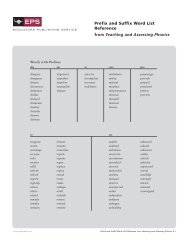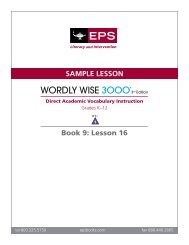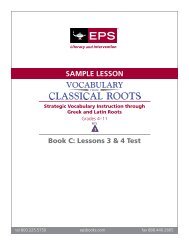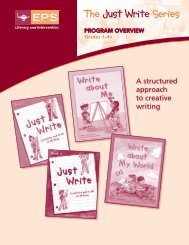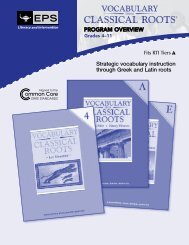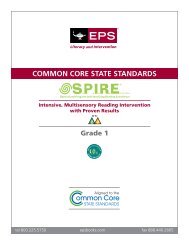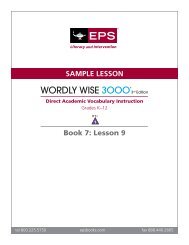Essential Knowledge and Skills for English Language Arts - School ...
Essential Knowledge and Skills for English Language Arts - School ...
Essential Knowledge and Skills for English Language Arts - School ...
Create successful ePaper yourself
Turn your PDF publications into a flip-book with our unique Google optimized e-Paper software.
Correlated to the:<br />
Texas<br />
<strong>Essential</strong> <strong>Knowledge</strong> <strong>and</strong> <strong>Skills</strong><br />
<strong>for</strong> <strong>English</strong> <strong>Language</strong> <strong>Arts</strong> <strong>and</strong> Reading<br />
K–4<br />
PRODUCTS BY<br />
tel 800.225.5750 fax 888.440.2665 intervention.schoolspecialty.com
Explode the Code ®<br />
Correlated to the<br />
Texas <strong>Essential</strong> <strong>Knowledge</strong> <strong>and</strong> <strong>Skills</strong> <strong>for</strong> <strong>English</strong> <strong>Language</strong> <strong>Arts</strong> <strong>and</strong> Reading<br />
Grade K<br />
The following pages contain examples from components in Explode the Code that align to the Texas <strong>Essential</strong> <strong>Knowledge</strong> <strong>and</strong> <strong>Skills</strong> <strong>for</strong> <strong>English</strong> <strong>Language</strong> <strong>Arts</strong> <strong>and</strong><br />
Reading. This correlation is intended to illustrate the program’s approach to these st<strong>and</strong>ards <strong>and</strong> to cite one or two examples of where a particular st<strong>and</strong>ard is met<br />
within the program. This is not a comprehensive list of every occurrence of a particular st<strong>and</strong>ard within Explode the Code. If this type of comprehensive document is<br />
what you require, please contact us at 800-435-7728 <strong>and</strong> ask to speak to a Product Manager. All examples are taken from Level 1 unless specified.<br />
For purposes of this correlation, the following abbreviations apply: TG = Teacher’s Guide; BC = Beyond the Code; BK = Book; N/A = Not Applicable.<br />
STANDARDS/EXPECTATIONS<br />
5. The student demonstrates knowledge of concepts of print.<br />
(A) recognize that print represents spoken language <strong>and</strong> conveys meaning such<br />
as his/her own name <strong>and</strong> signs such as Exit <strong>and</strong> Danger<br />
Reading: Print Awareness<br />
(B) know that print moves left-to-right across the page <strong>and</strong> top-to-bottom TG A, p. 9<br />
(C) underst<strong>and</strong> that written words are separated by spaces<br />
(D) know the difference between individual letters <strong>and</strong> printed words<br />
(E) know the difference between capital <strong>and</strong> lowercase letters<br />
N/A<br />
N/A<br />
N/A<br />
A, B, C<br />
Component<br />
(F) recognize how readers use capitalization <strong>and</strong> punctuation to comprehend BK 1 ½, Lesson 1, p. 6; TG 1, Lesson 5, p. 17<br />
(G) underst<strong>and</strong> that spoken words are represented in written language by<br />
specific sequences of letters<br />
(H) recognize that different parts of a book such as cover, title page, <strong>and</strong> table<br />
of contents offer in<strong>for</strong>mation<br />
N/A<br />
N/A<br />
Reading: Phonological Awareness<br />
6. The student orally demonstrates phonological awareness (an underst<strong>and</strong>ing that spoken language is composed of sequences of sounds).<br />
(A) demonstrate the concept of word by dividing spoken sentences into<br />
individual words<br />
N/A<br />
intervention.schoolspecialty.com 1
STANDARDS/EXPECTATIONS<br />
(B) identify, segment, <strong>and</strong> combine syllables within spoken words such as by<br />
clapping syllables <strong>and</strong> moving manipulatives to represent syllables in words<br />
(C) produce rhyming words <strong>and</strong> distinguish rhyming words from non-rhyming<br />
words<br />
TG 4, Lesson 3, p. 41<br />
TG 1, Lesson 7, p. 21<br />
(D) identify <strong>and</strong> isolate the initial <strong>and</strong> final sound of a spoken word TG 1, Lessons 1 & 2, pp. 7–11<br />
(E) blend sounds to make spoken words such as moving manipulatives to blend<br />
phonemes in a spoken word<br />
(F) segment one-syllable spoken words into individual phonemes, clearly<br />
producing beginning, medial, <strong>and</strong> final sounds<br />
7. The student uses letter-sound knowledge to decode written language.<br />
(A) name <strong>and</strong> identify each letter of the alphabet<br />
(B) underst<strong>and</strong> that written words are composed of letters that represent<br />
sounds<br />
(C) learn <strong>and</strong> apply letter-sound correspondences of a set of consonants <strong>and</strong><br />
vowels to begin to read<br />
8. The student develops an extensive vocabulary.<br />
(A) discuss meanings of words <strong>and</strong> develop vocabulary through meaningful/<br />
concrete experiences<br />
(B) develop vocabulary by listening to <strong>and</strong> discussing both familiar <strong>and</strong><br />
conceptually challenging selections read aloud<br />
(C) identify words that name persons, places, or things <strong>and</strong> words that name<br />
actions<br />
Reading: Phonics<br />
TG 1, Lesson 1, p. 7<br />
TG 1, Lesson 4, p. 14<br />
A, B, C<br />
A, B, C<br />
Reading: Comprehension<br />
9. The student uses a variety of strategies to comprehend selections read aloud.<br />
(A) use prior knowledge to anticipate meaning <strong>and</strong> make sense of texts<br />
(B) establish purposes <strong>for</strong> reading or listening such as to be in<strong>for</strong>med, to follow<br />
directions, <strong>and</strong> to be entertained<br />
(C) retell or act out the order of important events in stories<br />
Component<br />
TG 1, Lesson 1, p. 7; BK 1, Lesson 1, p. 2; BC 1, p. 1<br />
All selections in Beyond the Code can be used to meet this st<strong>and</strong>ard.<br />
All selections in Beyond the Code can be used to meet this st<strong>and</strong>ard.<br />
All selections in Beyond the Code can be used to meet this st<strong>and</strong>ard.<br />
All selections in Beyond the Code can be used to meet this st<strong>and</strong>ard.<br />
All selections in Beyond the Code can be used to meet this st<strong>and</strong>ard.<br />
All selections in Beyond the Code can be used to meet this st<strong>and</strong>ard.<br />
intervention.schoolspecialty.com 2
STANDARDS/EXPECTATIONS<br />
10. The student responds to various texts.<br />
(A) listen to stories being read aloud<br />
(B) participate actively (react, speculate, join in, read along) when predictable<br />
<strong>and</strong> patterned selections are read aloud<br />
C) respond through talk, movement, music, art, drama, <strong>and</strong> writing to a variety<br />
of stories <strong>and</strong> poems in ways that reflect underst<strong>and</strong>ing <strong>and</strong> interpretation<br />
Reading: Literary Response<br />
Component<br />
All selections in Beyond the Code can be used to meet this st<strong>and</strong>ard.<br />
All selections in Beyond the Code can be used to meet this st<strong>and</strong>ard.<br />
All selections in Beyond the Code can be used to meet this st<strong>and</strong>ard.<br />
D) describe how illustrations contribute to the text All selections in Beyond the Code can be used to meet this st<strong>and</strong>ard.<br />
11. The student recognizes characteristics of various types of texts<br />
(A) distinguish different <strong>for</strong>ms of texts such as lists, newsletters, <strong>and</strong> signs <strong>and</strong><br />
the functions they serve<br />
(B) underst<strong>and</strong> simple story structure<br />
(C) distinguish fiction from nonfiction, including fact <strong>and</strong> fantasy<br />
(D) underst<strong>and</strong> literary <strong>for</strong>ms by recognizing <strong>and</strong> distinguishing among such<br />
types of text as stories, poems, <strong>and</strong> in<strong>for</strong>mation books<br />
(E) underst<strong>and</strong> literary terms by distinguishing between the roles of the author<br />
<strong>and</strong> illustrator such as the author writes the story <strong>and</strong> the illustrator draws the<br />
pictures<br />
Reading: Text Structures/Literary Concepts<br />
N/A<br />
All selections in Beyond the Code can be used to meet this st<strong>and</strong>ard.<br />
N/A<br />
N/A<br />
N/A<br />
Reading: Inquiry/Research<br />
12. The student generates questions <strong>and</strong> conducts research about topics introduced through selections read aloud <strong>and</strong> from a variety of other sources.<br />
(A) identify relevant questions <strong>for</strong> inquiry such as “Why did knights wear armor”<br />
(B) use pictures, print, <strong>and</strong> people to gather in<strong>for</strong>mation <strong>and</strong> answer questions<br />
(C) draw conclusions from in<strong>for</strong>mation gathered<br />
(D) locate important areas of the library/media center<br />
All selections in Beyond the Code can be used to meet this st<strong>and</strong>ard.<br />
All selections in Beyond the Code can be used to meet this st<strong>and</strong>ard.<br />
All selections in Beyond the Code can be used to meet this st<strong>and</strong>ard.<br />
N/A<br />
intervention.schoolspecialty.com 3
STANDARDS/EXPECTATIONS<br />
Reading: Culture<br />
Component<br />
13. The student reads or listens to increase knowledge of his/her own culture, the culture of others, <strong>and</strong> the common elements of cultures<br />
(A) connect his/her own experiences with the life experiences, language,<br />
customs, <strong>and</strong> culture of others<br />
(B) compare experiences of characters across cultures<br />
All selections in Beyond the Code can be used to meet this st<strong>and</strong>ard.<br />
N/A<br />
intervention.schoolspecialty.com 4
Explode the Code ®<br />
Correlated to the<br />
Texas <strong>Essential</strong> <strong>Knowledge</strong> <strong>and</strong> <strong>Skills</strong> <strong>for</strong> <strong>English</strong> <strong>Language</strong> <strong>Arts</strong> <strong>and</strong> Reading<br />
Grade 1<br />
The following pages contain examples from components in Explode the Code that align to the Texas <strong>Essential</strong> <strong>Knowledge</strong> <strong>and</strong> <strong>Skills</strong> <strong>for</strong> <strong>English</strong> <strong>Language</strong> <strong>Arts</strong> <strong>and</strong><br />
Reading. This correlation is intended to illustrate the program’s approach to these st<strong>and</strong>ards <strong>and</strong> to cite one or two examples of where a particular st<strong>and</strong>ard is met<br />
within the program. This is not a comprehensive list of every occurrence of a particular st<strong>and</strong>ard within Explode the Code. If this type of comprehensive document is<br />
what you require, please contact us at 800-435-7728 <strong>and</strong> ask to speak to a Product Manager. All examples are taken from Level 1 unless specified.<br />
For purposes of this correlation, the following abbreviations apply: TG = Teacher’s Guide; BC = Beyond the Code; BK = Book; N/A = Not Applicable.<br />
STANDARDS/EXPECTATIONS<br />
5. The student demonstrates knowledge of concepts of print.<br />
(A) recognize that print represents spoken language <strong>and</strong> conveys meaning such<br />
as his/her own name <strong>and</strong> signs such as Exit <strong>and</strong> Danger<br />
Reading: Print Awareness<br />
(B) know that print moves left-to-right across the page <strong>and</strong> top-to-bottom TG A, p. 9<br />
(C) underst<strong>and</strong> that written words are separated by spaces<br />
(D) know the difference between individual letters <strong>and</strong> printed words<br />
(E) know the order of the alphabet<br />
(F) know the difference between capital <strong>and</strong> lowercase letters<br />
N/A<br />
N/A<br />
N/A<br />
N/A<br />
A, B, C<br />
Component<br />
(G) recognize how readers use capitalization <strong>and</strong> punctuation to comprehend BK 1 ½, Lesson 1, p. 6; TG 1, Lesson 5, p. 17<br />
(H) underst<strong>and</strong> that spoken words are represented in written language by<br />
specific sequences of letters<br />
(I) recognize that different parts of a book such as cover, title page, <strong>and</strong> table of<br />
contents offer in<strong>for</strong>mation<br />
(J) recognize that there are correct spellings <strong>for</strong> words<br />
(K) recognize the distinguishing features of a paragraph<br />
N/A<br />
N/A<br />
N/A<br />
N/A<br />
intervention.schoolspecialty.com 5
STANDARDS/EXPECTATIONS<br />
Reading: Phonological Awareness<br />
Component<br />
6. The student orally demonstrates phonological awareness (an underst<strong>and</strong>ing that spoken language is composed of sequences of sounds).<br />
(A) demonstrate the concept of word by dividing spoken sentences into<br />
individual words<br />
(B) identify, segment, <strong>and</strong> combine syllables within spoken words such as by<br />
clapping syllables <strong>and</strong> moving manipulatives to represent syllables in words<br />
(C) produce rhyming words <strong>and</strong> distinguish rhyming words from non-rhyming<br />
words<br />
N/A<br />
TG 4, Lesson 3, p. 41<br />
TG 1, Lesson 7, p. 21<br />
(D) identify <strong>and</strong> isolate the initial <strong>and</strong> final sound of a spoken word TG 1, Lessons 1 & 2, pp. 7–11<br />
(E) blend sounds to make spoken words, including three <strong>and</strong> four phoneme<br />
words, through ways such as moving manipulatives to blend phonemes in a<br />
spoken word<br />
(F) segment one-syllable spoken words into individual phonemes, including<br />
three <strong>and</strong> four phoneme words, clearly producing beginning, medial, <strong>and</strong> final<br />
sounds<br />
7. The student uses letter-sound knowledge to decode written language.<br />
(A) name <strong>and</strong> identify each letter of the alphabet<br />
(B) underst<strong>and</strong> that written words are composed of letters that represent<br />
sounds<br />
(C) learn <strong>and</strong> apply letter-sound correspondences of a set of consonants <strong>and</strong><br />
vowels to begin to read<br />
(D) learn <strong>and</strong> apply the most common letter-sound correspondences, including<br />
the sounds represented by single letters (consonants <strong>and</strong> vowels); consonant<br />
blends such as bl, st, tr; consonant digraphs such as th, sh, ck; <strong>and</strong> vowel<br />
digraphs <strong>and</strong> diphthongs such as ea, ie, ee<br />
(E) blend initial letter-sounds with common vowel spelling patterns to read<br />
words<br />
(F) decode by using all letter-sound correspondences within regularly spelled<br />
words<br />
Reading: Phonics<br />
TG 1, Lesson 1, p. 7<br />
TG 1, Lesson 4, p. 14<br />
A, B, C<br />
N/A<br />
TG 1, Lesson 1, p. 7; BK 1, Lesson 1, p. 2; BC 1, p. 1<br />
BK 2, Lesson 1, p. 1; TG 2, Lesson 1, p. 33; BC 1, pp. 5–7<br />
TG 1, Lesson 11, p. 29; BK 1, Lesson 11, p. 85; BC 1, p. 1<br />
All selections in Beyond the Code can be used to meet this st<strong>and</strong>ard.<br />
intervention.schoolspecialty.com 6
STANDARDS/EXPECTATIONS<br />
(G) use letter-sound knowledge to read decodable texts (engaging <strong>and</strong> coherent<br />
texts in which most of the words are comprised of an accumulating sequence<br />
of letter-sound correspondences being taught)<br />
Component<br />
All selections in Beyond the Code can be used to meet this st<strong>and</strong>ard.<br />
8. The student uses a variety of word identification strategies.<br />
(A) decode by using all letter-sound correspondences within a word<br />
(B) use common spelling patterns to read words<br />
(C) use structural cues to recognize words such as compounds, base words,<br />
<strong>and</strong> inflections such as -s, -es, -ed, <strong>and</strong> -ing<br />
All selections in Beyond the Code can be used to meet this st<strong>and</strong>ard.<br />
All selections in Beyond the Code can be used to meet this st<strong>and</strong>ard.<br />
TG 4, Lesson 1, p. 37; WB 4, Lesson 1, p. 1 (compounds)<br />
(D) identify multisyllabic words by using common syllable patterns TG 4, Lesson 7, p. 49; WB 4, Lesson 7, p. 43<br />
(E) recognize high frequency irregular words such as said, was, where, <strong>and</strong> is TG 1, Lesson 1, p. 8; BK 1, Lesson 1, p. 8; BC 1, p. 3<br />
(F) use knowledge of word order (syntax) <strong>and</strong> context to support word<br />
identification <strong>and</strong> confirm word meaning<br />
(G) read both regular <strong>and</strong> irregular words automatically such as through<br />
multiple opportunities to read <strong>and</strong> reread<br />
All selections in Beyond the Code can be used to meet this st<strong>and</strong>ard.<br />
All selections in Beyond the Code can be used to meet this st<strong>and</strong>ard.<br />
Reading: Fluency<br />
9. The student reads with fluency <strong>and</strong> underst<strong>and</strong>ing in texts at appropriate difficulty levels.<br />
(A) read regularly in independent-level materials (texts in which no more than<br />
approximately 1 in 20 words is difficult <strong>for</strong> the reader)<br />
(B) read regularly in instructional-level materials that are challenging but<br />
manageable (texts in which no more than approximately 1 in 10 words is difficult<br />
<strong>for</strong> the reader; a “typical” first grader reads approximately 60 wpm)<br />
(C) read orally from familiar texts with fluency (accuracy, expression,<br />
appropriate phrasing, <strong>and</strong> attention to punctuation)<br />
(D) self-select independent level reading such as by drawing on personal<br />
interest, by relying on knowledge of authors <strong>and</strong> different types of texts, <strong>and</strong>/or<br />
by estimating text difficulty<br />
All selections in Beyond the Code can be used to meet this st<strong>and</strong>ard.<br />
All selections in Beyond the Code can be used to meet this st<strong>and</strong>ard.<br />
All selections in Beyond the Code can be used to meet this st<strong>and</strong>ard.<br />
All selections in Beyond the Code can be used to meet this st<strong>and</strong>ard.<br />
intervention.schoolspecialty.com 7
STANDARDS/EXPECTATIONS<br />
10. The student reads widely <strong>for</strong> different purposes in varied sources.<br />
(A) read fiction, nonfiction, <strong>and</strong> poetry, including classic <strong>and</strong> contemporary<br />
works, <strong>for</strong> pleasure <strong>and</strong>/or in<strong>for</strong>mation<br />
(B) use graphs, charts, signs, captions, <strong>and</strong> other in<strong>for</strong>mational texts to acquire<br />
in<strong>for</strong>mation<br />
11. The student develops an extensive vocabulary.<br />
(A) discuss meanings of words <strong>and</strong> develop vocabulary through meaningful/<br />
concrete experiences<br />
(B) develop vocabulary by listening to <strong>and</strong> discussing both familiar <strong>and</strong><br />
conceptually challenging selections read aloud<br />
(C) identify words that name persons, places, or things <strong>and</strong> words that name<br />
actions<br />
N/A<br />
N/A<br />
Reading: Vocabulary<br />
Reading: Comprehension<br />
Component<br />
All selections in Beyond the Code can be used to meet this st<strong>and</strong>ard.<br />
All selections in Beyond the Code can be used to meet this st<strong>and</strong>ard.<br />
All selections in Beyond the Code can be used to meet this st<strong>and</strong>ard.<br />
12. The student uses a variety of strategies to comprehend selections read aloud <strong>and</strong> selections read independently.<br />
(A) use prior knowledge to anticipate meaning <strong>and</strong> make sense of texts<br />
(B) establish purposes <strong>for</strong> reading <strong>and</strong> listening such as to be in<strong>for</strong>med, to<br />
follow directions, <strong>and</strong> to be entertained<br />
(C) retell or act out the order of important events in stories<br />
(D) monitor his/her own comprehension <strong>and</strong> act purposefully when<br />
comprehension breaks down using strategies such as rereading, searching <strong>for</strong><br />
clues, <strong>and</strong> asking <strong>for</strong> help<br />
(E) draw <strong>and</strong> discuss visual images based on text descriptions<br />
(F) make <strong>and</strong> explain inferences from texts such as determining important<br />
ideas <strong>and</strong> causes <strong>and</strong> effects, making predictions, <strong>and</strong> drawing conclusions<br />
(G) identify similarities <strong>and</strong> differences across texts such as in topics,<br />
characters, <strong>and</strong> problems<br />
All selections in Beyond the Code can be used to meet this st<strong>and</strong>ard.<br />
All selections in Beyond the Code can be used to meet this st<strong>and</strong>ard.<br />
All selections in Beyond the Code can be used to meet this st<strong>and</strong>ard.<br />
All selections in Beyond the Code can be used to meet this st<strong>and</strong>ard.<br />
All selections in Beyond the Code can be used to meet this st<strong>and</strong>ard.<br />
All selections in Beyond the Code can be used to meet this st<strong>and</strong>ard.<br />
All selections in Beyond the Code can be used to meet this st<strong>and</strong>ard.<br />
intervention.schoolspecialty.com 8
Explode the Code ®<br />
Correlated to the<br />
Texas <strong>Essential</strong> <strong>Knowledge</strong> <strong>and</strong> <strong>Skills</strong> <strong>for</strong> <strong>English</strong> <strong>Language</strong> <strong>Arts</strong> <strong>and</strong> Reading<br />
Grade 2<br />
The following pages contain examples from components in Explode the Code that align to the Texas <strong>Essential</strong> <strong>Knowledge</strong> <strong>and</strong> <strong>Skills</strong> <strong>for</strong> <strong>English</strong> <strong>Language</strong> <strong>Arts</strong> <strong>and</strong><br />
Reading. This correlation is intended to illustrate the program’s approach to these st<strong>and</strong>ards <strong>and</strong> to cite one or two examples of where a particular st<strong>and</strong>ard is met<br />
within the program. This is not a comprehensive list of every occurrence of a particular st<strong>and</strong>ard within Explode the Code. If this type of comprehensive document is<br />
what you require, please contact us at 800-435-7728 <strong>and</strong> ask to speak to a Product Manager. All examples are taken from Level 1 unless specified.<br />
For purposes of this correlation, the following abbreviations apply: TG = Teacher’s Guide; BC = Beyond the Code; BK = Book; N/A = Not Applicable.<br />
STANDARDS/EXPECTATIONS<br />
5. The student uses a variety of word identification strategies.<br />
(A) decode by using all letter-sound correspondences within a word<br />
(B) blend initial letter - sounds with common vowel spelling patterns to read<br />
words<br />
Reading: Phonics<br />
Component<br />
All selections in Beyond the Code can be used to meet this st<strong>and</strong>ard.<br />
TG 1, Lesson 11, p. 29; BK 1, Lesson 11, p. 85; BC 1, p. 1<br />
(C) recognize high-frequency irregular words such as said, was, where, <strong>and</strong> is TG 1, Lesson 1, p. 8; BK 1, Lesson 1, p. 8; BC 1, p. 3<br />
(D) identify multisyllabic words by using common syllable patterns TG 4, Lesson 7, p. 49; WB 4, Lesson 7, p. 43<br />
(E) use structural cues to recognize words such as compound, base words, <strong>and</strong><br />
inflections such as -s, -es, -ed, <strong>and</strong> -ing<br />
(F) use structural cues such as prefixes <strong>and</strong> suffixes to recognize words, <strong>for</strong><br />
example, un- <strong>and</strong> -ly<br />
(G) use knowledge of word order (syntax) <strong>and</strong> context to support word<br />
identification <strong>and</strong> confirm word meaning<br />
(H) read both regular <strong>and</strong> irregular words automatically such as through<br />
multiple opportunities to read <strong>and</strong> reread<br />
Reading: Fluency<br />
6. The student reads with fluency <strong>and</strong> underst<strong>and</strong>ing in texts at appropriate difficulty levels.<br />
(A) read regularly in independent-level materials (texts in which no more than<br />
approximately 1 in 20 words is difficult <strong>for</strong> the reader)<br />
TG 4, Lesson 1, p. 37; WB 4, Lesson 1, p. 1 (compounds)<br />
BC 2, p. 15 (prefixes); BK 4, Lesson 2, p. 9; TG 4, Lesson 2, p. 39 (suffixes)<br />
All selections in Beyond the Code can be used to meet this st<strong>and</strong>ard.<br />
All selections in Beyond the Code can be used to meet this st<strong>and</strong>ard.<br />
All selections in Beyond the Code can be used to meet this st<strong>and</strong>ard.<br />
intervention.schoolspecialty.com 9
STANDARDS/EXPECTATIONS<br />
(B) read regularly in instructional-level materials that are challenging but<br />
manageable (texts in which no more than approximately 1 in 10 words is<br />
difficult <strong>for</strong> the reader; a<br />
“typical” second grader reads approximately 70 wpm)<br />
(C) read orally from familiar texts with fluency (accuracy, expression,<br />
appropriate phrasing, <strong>and</strong> attention to punctuation)<br />
(D) self-select independent-level reading by drawing on personal interests,<br />
by relying on knowledge of authors <strong>and</strong> different types of texts, <strong>and</strong>/or by<br />
estimating text difficulty<br />
(E) read silently <strong>for</strong> increasing periods of time<br />
7. The student reads widely <strong>for</strong> different purposes in varied sources.<br />
(A) read classic <strong>and</strong> contemporary works<br />
(B) read from a variety of genres <strong>for</strong> pleasure <strong>and</strong> to acquire in<strong>for</strong>mation from<br />
both print <strong>and</strong> electronic sources<br />
(C) read to accomplish various purposes, both assigned <strong>and</strong> self-selected<br />
8. The student develops an extensive vocabulary.<br />
(A) discuss meanings of words <strong>and</strong> develop vocabulary through meaningful/<br />
concrete experiences<br />
(B) develop vocabulary by listening to <strong>and</strong> discussing both familiar <strong>and</strong><br />
conceptually challenging selections read aloud<br />
(C) develop vocabulary through reading<br />
(D) use resources <strong>and</strong> references such as beginners’ dictionaries, glossaries,<br />
available technology, <strong>and</strong> context to build word meanings <strong>and</strong> to confirm<br />
pronunciation of words<br />
Component<br />
All selections in Beyond the Code can be used to meet this st<strong>and</strong>ard.<br />
All selections in Beyond the Code can be used to meet this st<strong>and</strong>ard.<br />
All selections in Beyond the Code can be used to meet this st<strong>and</strong>ard.<br />
N/A<br />
N/A<br />
N/A<br />
N/A<br />
Reading: Vocabulary<br />
All selections in Beyond the Code can be used to meet this st<strong>and</strong>ard.<br />
All selections in Beyond the Code can be used to meet this st<strong>and</strong>ard.<br />
All selections in Beyond the Code can be used to meet this st<strong>and</strong>ard.<br />
N/A<br />
Reading: Comprehension<br />
9. The student uses a variety of strategies to comprehend selections read aloud <strong>and</strong> selections read independently.<br />
(A) use prior knowledge to anticipate meaning <strong>and</strong> make sense of texts<br />
All selections in Beyond the Code can be used to meet this st<strong>and</strong>ard.<br />
intervention.schoolspecialty.com 10
STANDARDS/EXPECTATIONS<br />
(B) establish purposes <strong>for</strong> reading <strong>and</strong> listening such as to be in<strong>for</strong>med, to<br />
follow directions, <strong>and</strong> to be entertained<br />
(C) retell or act out the order of important events in stories<br />
(D) monitor his/her own comprehension <strong>and</strong> act purposefully when<br />
comprehension breaks down such as rereading, searching <strong>for</strong> clues, <strong>and</strong> asking<br />
<strong>for</strong> help<br />
(E) draw <strong>and</strong> discuss visual images based on text descriptions<br />
(F) make <strong>and</strong> explain inferences from texts such as determining important<br />
ideas <strong>and</strong> causes <strong>and</strong> effects, making predictions, <strong>and</strong> drawing conclusions<br />
(G) identify similarities <strong>and</strong> differences across texts such as in topics,<br />
characters, <strong>and</strong> problems<br />
(H) produce summaries of text selections<br />
(I) represent text in<strong>for</strong>mation in different ways, including story maps, graphs,<br />
<strong>and</strong> charts<br />
Component<br />
All selections in Beyond the Code can be used to meet this st<strong>and</strong>ard.<br />
All selections in Beyond the Code can be used to meet this st<strong>and</strong>ard.<br />
All selections in Beyond the Code can be used to meet this st<strong>and</strong>ard.<br />
All selections in Beyond the Code can be used to meet this st<strong>and</strong>ard.<br />
All selections in Beyond the Code can be used to meet this st<strong>and</strong>ard.<br />
All selections in Beyond the Code can be used to meet this st<strong>and</strong>ard.<br />
All selections in Beyond the Code can be used to meet this st<strong>and</strong>ard.<br />
N/A<br />
intervention.schoolspecialty.com 11
Explode the Code ®<br />
Correlated to the<br />
Texas <strong>Essential</strong> <strong>Knowledge</strong> <strong>and</strong> <strong>Skills</strong> <strong>for</strong> <strong>English</strong> <strong>Language</strong> <strong>Arts</strong> <strong>and</strong> Reading<br />
Grade 3<br />
The following pages contain examples from components in Explode the Code that align to the Texas <strong>Essential</strong> <strong>Knowledge</strong> <strong>and</strong> <strong>Skills</strong> <strong>for</strong> <strong>English</strong> <strong>Language</strong> <strong>Arts</strong> <strong>and</strong><br />
Reading. This correlation is intended to illustrate the program’s approach to these st<strong>and</strong>ards <strong>and</strong> to cite one or two examples of where a particular st<strong>and</strong>ard is met<br />
within the program. This is not a comprehensive list of every occurrence of a particular st<strong>and</strong>ard within Explode the Code. If this type of comprehensive document is<br />
what you require, please contact us at 800-435-7728 <strong>and</strong> ask to speak to a Product Manager.<br />
For purposes of this correlation, the following abbreviations apply: TG = Teacher’s Guide; BC = Beyond the Code;BK = Book; N/A = Not Applicable.<br />
STANDARDS/SKILLS<br />
5. The student uses a variety of word identification strategies.<br />
(A) decode by using all letter-sound correspondences within a word<br />
(B) blend initial letter-sounds with common vowel spelling patterns to read<br />
words<br />
Reading: Phonics<br />
Component<br />
All lessons in the TG use letter-sound correspondences within a word to decode.<br />
TG 3, Lesson 13, p. 33<br />
TG 4, Lesson 7, pp. 48-49<br />
TG 4, Lesson 2, pp. 39-40<br />
BK 4, Lesson 2, pp. 9-16<br />
TG 5, Lesson 4, pp. 13-14<br />
TG 6, Lesson 6, pp. 42-44<br />
BK 6, Lesson 6, pp. 41-48<br />
(C) identify multisyllabic words by using common syllable patterns TG 4, Lesson 4, p. 43<br />
BK 4, Lesson 11, pp. 75-76<br />
TG 8, Lesson 8 – Fluency, p. 49<br />
BK 8, Lesson 8, p. 59<br />
(D) use root words <strong>and</strong> other structural cues such as prefixes, suffixes, <strong>and</strong><br />
derivational endings to recognize words<br />
(E) use knowledge of word order (syntax) <strong>and</strong> context to support word<br />
identification <strong>and</strong> confirm word meaning<br />
TG 8, Lesson 1, pp. 36-37; Lesson 7, pp. 46-47<br />
BK 8, Lesson 8, pp. 59-67<br />
All reading selections from BC 1-4; BK 7-8<br />
BK 7, Lesson 9, p. 67; Lesson 13, p. 107<br />
TG 7, Lesson 9, p. 21<br />
intervention.schoolspecialty.com 12
STANDARDS/SKILLS<br />
(F) read both regular <strong>and</strong> irregular words automatically such as through<br />
multiple opportunities to read <strong>and</strong> reread<br />
Reading: Fluency<br />
6. The student reads with fluency <strong>and</strong> underst<strong>and</strong>ing in texts at appropriate difficulty levels.<br />
(A) read regularly in independent-level materials (texts in which no more than<br />
approximately 1 in 20 words is difficult <strong>for</strong> the reader)<br />
(B) read regularly in instructional-level materials that are challenging but<br />
manageable (texts in which no more than approximately 1 in 10 words is<br />
difficult <strong>for</strong> the reader; the “typical” third grader reads 80 wpm)<br />
(C) read orally from familiar texts with fluency (accuracy, expression,<br />
appropriate phrasing, <strong>and</strong> attention to punctuation)<br />
(D) self-select independent-level reading such as by drawing on personal<br />
interests, by relying on knowledge of authors <strong>and</strong> different types of texts, <strong>and</strong>/or<br />
by estimating text difficulty<br />
Component<br />
All reading selections from BC 1-4; BK 7-8<br />
TG 5, Lesson 11, p. 28<br />
All reading selections from BC 1-4; BK 7-8<br />
All reading selections from BC 1-4; BK 7-8<br />
TG 5, Lesson 5 – Fluency, p. 16<br />
All reading selections from BC 1-4; BK 7-8<br />
TG 4, Lesson 11, p. 30<br />
TG 6, Lesson 5 – Fluency, p. 41<br />
TG 8, Lesson 6 – Fluency, p. 45<br />
(E) read silently <strong>for</strong> increasing periods of time All reading selections from BC 1-4; BK 7-8<br />
7. The student reads widely <strong>for</strong> different purposes in varied sources.<br />
(A) read classic <strong>and</strong> contemporary works<br />
(B) read from a variety of genres <strong>for</strong> pleasure <strong>and</strong> to acquire in<strong>for</strong>mation from<br />
both print <strong>and</strong> electronic sources<br />
(C) read to accomplish various purposes, both assigned <strong>and</strong> self-selected All reading selections from BC 1-4; BK 7-8<br />
8. The student develops an extensive vocabulary.<br />
(A) develop vocabulary by listening to <strong>and</strong> discussing both familiar <strong>and</strong><br />
conceptually challenging selections read aloud<br />
N/A<br />
N/A<br />
N/A<br />
Reading: Vocabulary<br />
All reading selections from BC 1-4; BK 7-8<br />
(B) develop vocabulary through reading All reading selections from BC 1-4; BK 7-8<br />
intervention.schoolspecialty.com 13
STANDARDS/SKILLS<br />
(C) use resources <strong>and</strong> references such as beginners’ dictionaries, glossaries,<br />
available technology, <strong>and</strong> context to build word meanings <strong>and</strong> to confirm<br />
pronunciations of words<br />
(D) demonstrate knowledge of synonyms, antonyms, <strong>and</strong> multi-meaning words<br />
(<strong>for</strong> example, by sorting, classifying, <strong>and</strong> identifying related words)<br />
Component<br />
TG 7, Lesson 9, p. 21<br />
BK 7, Lesson 9, p. 67; Lesson 13, p. 107<br />
TG 8, Lesson 9 – Challenge, p. 51; Lesson 10, p. 53<br />
TG 3, Lesson 7, p. 21; Lesson 10, p. 28<br />
TG 4, Lesson 10, p. 56<br />
BC 4, p. 44; p. 61<br />
TG 6, Lesson 1, p. 32; Lesson 3, p. 37<br />
TG 7, Lesson 9, p. 22; Lesson 10, p. 23<br />
BK 8, Lesson 5, p. 37; Lesson 9, p. 69<br />
Reading: Comprehension<br />
9. The student uses a variety of strategies to comprehend selections read aloud <strong>and</strong> selections read independently.<br />
(A) use prior knowledge to anticipate meaning <strong>and</strong> make sense of texts<br />
(B) establish purposes <strong>for</strong> reading <strong>and</strong> listening such as to be in<strong>for</strong>med, to<br />
follow directions, <strong>and</strong> to be entertained<br />
All lessons use prior knowledge to anticipate meaning.<br />
TG 6, Lesson 8, p. 46<br />
TG 7, Lesson 14, p. 29<br />
N/A<br />
(C) retell or act out the order of important events in stories TG 6, Lesson 8, p. 47<br />
TG 8, Lesson 11 – Fluency, p. 54; Lesson 12 – Fluency, p. 56<br />
(D) monitor his/her own comprehension <strong>and</strong> act purposefully when<br />
comprehension breaks down using such strategies as rereading, searching <strong>for</strong><br />
clues, <strong>and</strong> asking <strong>for</strong> help<br />
All reading selections from BC 1-4; BK 7-8<br />
TG 5, Lesson 11, p. 28 (Repeated Reading)<br />
(E) draw <strong>and</strong> discuss visual images based on text descriptions TG 6, Lesson 7 – Comprehension, p. 45<br />
BC 4, p. 77<br />
(F) make <strong>and</strong> explain inferences from texts such as determining important<br />
ideas, causes <strong>and</strong> effects, making predictions, <strong>and</strong> drawing conclusions<br />
(G) identify similarities <strong>and</strong> differences across texts such as in topics,<br />
characters, <strong>and</strong> themes<br />
BC 1-4; BK 7-8<br />
The reading selections presented in BC 1-4 <strong>and</strong> BK 7-8 can be used to predict<br />
events <strong>and</strong> actions by previewing with the teacher. After reading each selection,<br />
teachers can use predictions to verify in<strong>for</strong>mation.<br />
All reading selections from BC 1-4; BK 7-8<br />
(H) produce summaries of text selections All reading selections from BC 1-4; BK 7-8<br />
intervention.schoolspecialty.com 14
STANDARDS/SKILLS<br />
(I) represent text in<strong>for</strong>mation in different ways, including story maps, graphs,<br />
<strong>and</strong> charts<br />
(J) distinguish fact from opinion in various texts, including news stories <strong>and</strong><br />
advertisements<br />
(K) practice different kinds of questions <strong>and</strong> tasks, including test-like<br />
comprehension questions<br />
BC 4 <strong>and</strong> BK 1-8<br />
TG 8, Lesson 7, p. 47<br />
N/A<br />
Component<br />
BC 4, pp. 83-98<br />
BK 8, Lesson 13, pp. 104-105; Posttest, pp. 106-109<br />
intervention.schoolspecialty.com 15
Explode the Code ®<br />
Correlated to the<br />
Texas <strong>Essential</strong> <strong>Knowledge</strong> <strong>and</strong> <strong>Skills</strong> <strong>for</strong> <strong>English</strong> <strong>Language</strong> <strong>Arts</strong> <strong>and</strong> Reading<br />
Grade 4<br />
The following pages contain examples from components in Explode the Code that align to the Texas <strong>Essential</strong> <strong>Knowledge</strong> <strong>and</strong> <strong>Skills</strong> <strong>for</strong> <strong>English</strong> <strong>Language</strong> <strong>Arts</strong> <strong>and</strong><br />
Reading. This correlation is intended to illustrate the program’s approach to these st<strong>and</strong>ards <strong>and</strong> to cite one or two examples of where a particular st<strong>and</strong>ard is met<br />
within the program. This is not a comprehensive list of every occurrence of a particular st<strong>and</strong>ard within Explode the Code. If this type of comprehensive document is<br />
what you require, please contact us at 800-435-7728 <strong>and</strong> ask to speak to a Product Manager.<br />
For purposes of this correlation, the following abbreviations apply: TG = Teacher’s Guide; BC = Beyond the Code; BK = Book; N/A = Not Applicable.<br />
STANDARDS/SKILLS Component<br />
6. The student uses a variety of word identification strategies.<br />
(A) apply knowledge of letter-sound correspondences, language structure, <strong>and</strong><br />
context to recognize words<br />
(B) use structural analysis to identify root words with prefixes such as dis-,<br />
non-, in-; <strong>and</strong> suffixes such as -ness, -tion, -able<br />
(C) locate the meanings, pronunciations, <strong>and</strong> derivations of unfamiliar words<br />
using dictionaries, glossaries, <strong>and</strong> other sources<br />
Reading: Phonics<br />
Reading: Fluency<br />
7. The student reads with fluency <strong>and</strong> underst<strong>and</strong>ing in texts at appropriate difficulty levels.<br />
(A) read regularly in independent-level materials (texts in which no more than<br />
approximately 1 in 20 words is difficult <strong>for</strong> the reader)<br />
(B) read regularly in instructional-level materials that are challenging but<br />
manageable (texts in which no more than approximately 1 in 10 words is<br />
difficult <strong>for</strong> the reader; a “typical” fourth grader reads approximately 90 wpm)<br />
All lessons in the TG use letter-sound correspondences within a word, language<br />
structure, <strong>and</strong> context to recognize words.<br />
TG 3, Lesson 13, p. 33<br />
TG 4, Lesson 7, pp. 48-49<br />
TG 8, Lesson 1, pp. 36-37; Lessons 5-7, pp. 43-47<br />
BK 8, Lesson 8, pp. 59-67<br />
TG 7, Lesson 9, p. 21<br />
BK 7, Lesson 9, p. 67; Lesson 13, p. 107<br />
TG 8, Lesson 9 – Challenge, p. 51; Lesson 10, p. 53<br />
All reading selections from BC 1-4; BK 7-8<br />
All reading selections from BC 1-4; BK 7-8<br />
TG 5, Lesson 5 – Fluency, p. 16<br />
intervention.schoolspecialty.com 16
STANDARDS/SKILLS Component<br />
(C) demonstrate characteristics of fluent <strong>and</strong> effective reading All reading selections from BC 1-4; BK 7-8<br />
TG 4, Lesson 11, p. 30<br />
TG 6, Lesson 5 – Fluency, p. 41<br />
TG 8, Lesson 6 – Fluency, p. 45<br />
(D) adjust reading rate based on purposes <strong>for</strong> reading<br />
(E) read aloud in selected texts in ways that both reflect underst<strong>and</strong>ing of the<br />
text <strong>and</strong> engage the listeners<br />
N/A<br />
All reading selections from BC 1-4; BK 7-8<br />
TG 4, Lesson 11, p. 30<br />
TG 6, Lesson 5 – Fluency, p. 41<br />
TG 8, Lesson 6 – Fluency, p. 45<br />
(F) read silently with increasing ease <strong>for</strong> longer periods All reading selections from BC1-4; BK 7-8<br />
8. The student reads widely <strong>for</strong> different purposes in varied sources.<br />
(A) read classic <strong>and</strong> contemporary works<br />
(B) select varied sources such as nonfiction, novels, textbooks, newspapers,<br />
<strong>and</strong> magazines when reading <strong>for</strong> in<strong>for</strong>mation or pleasure<br />
(C) read <strong>for</strong> varied purposes such as to be in<strong>for</strong>med, to be entertained, to<br />
appreciate the writer’s craft, <strong>and</strong> to discover models <strong>for</strong> his/her own writing<br />
N/A<br />
N/A<br />
Reading: Vocabulary<br />
9. The student acquires an extensive vocabulary through reading <strong>and</strong> systematic word study.<br />
All reading selections from BC 1-4; BK 7-8<br />
TG 7, Lesson 14, p. 30<br />
TG 8, Lesson 9, p. 51<br />
(A) develop vocabulary by listening to selections read aloud All reading selections from BC 1-4; BK 7-8<br />
TG 6, Lesson 11, p. 53<br />
(B) draw on experiences to bring meanings to words in context such as<br />
interpreting figurative language <strong>and</strong> multiple-meaning words<br />
(C) use multiple reference aids, including a thesaurus, a synonym finder, a<br />
dictionary, <strong>and</strong> software, to clarify meanings <strong>and</strong> usage<br />
D) determine meanings of derivatives by applying knowledge of the meanings<br />
of root words such as like, pay, or happy <strong>and</strong> affixes such as dis-, pre-, un-<br />
TG 3, Lesson 7, p. 21; Lesson 10, p. 28<br />
TG 6, Lesson 6 – Challenge, p. 44<br />
BK 7, Lesson 13, p. 103; Lesson 15, p. 119<br />
TG 8, Lesson 7, p. 38; Lesson 9, p. 51<br />
BK 8, Lesson 10, p. 81<br />
TG 7, Lesson 9, p. 21<br />
BK 7, Lesson 9, p. 67; Lesson 13, p. 107<br />
TG 8, Lesson 9 – Challenge, p. 51; Lesson 10, p. 53<br />
TG 8, Lesson 1, pp. 36-37; Lesson 3, pp. 39-40<br />
intervention.schoolspecialty.com 17
STANDARDS/SKILLS Component<br />
(E) study word meanings systematically such as across curricular content<br />
areas <strong>and</strong> through current events<br />
10. The student comprehends selections using a variety of strategies.<br />
N/A<br />
Reading: Comprehension<br />
(A) use his/her own knowledge <strong>and</strong> experience to comprehend BC 4, pp. 51-59<br />
TG 6, Lesson 5, pp. 40-41<br />
TG 7, Lesson 11, pp. 24-25<br />
BK 7, Lesson 7, p. 55<br />
BK 8, Lesson 12, p. 97<br />
(B) establish <strong>and</strong> adjust purposes <strong>for</strong> reading such as reading to find out, to<br />
underst<strong>and</strong>, to interpret, to enjoy, <strong>and</strong> to solve problems<br />
(C) monitor his/her own comprehension <strong>and</strong> make modifications when<br />
underst<strong>and</strong>ing breaks down such as by reading clues <strong>and</strong> asking questions<br />
N/A<br />
All reading selections from BC 1-4; BK 7-8<br />
(D) describe mental images that text descriptions evoke All reading selections from BC 1-4; BK 7-8<br />
BK 8, Lesson 11, p. 89<br />
(E) use the text’s structure or progression of ideas such as cause <strong>and</strong> effect or<br />
chronology to locate <strong>and</strong> recall in<strong>for</strong>mation<br />
(F) determine a text’s main (or major) ideas <strong>and</strong> how those ideas are supported<br />
with details<br />
All reading selections from BC 1-4; BK 7-8<br />
BK 7, Lesson 12, p. 95<br />
All reading selections from BC 1-4; BK 7-8<br />
BK 8, Lesson 8, pp. 64-65; Lesson 13, pp. 104-105<br />
(G) paraphrase <strong>and</strong> summarize text to recall, in<strong>for</strong>m, <strong>and</strong> organize ideas All reading selections from BC 1-4; BK 7-8<br />
(H) draw inferences such as conclusions or generalizations <strong>and</strong> support them<br />
with text evidence <strong>and</strong> experience<br />
(I) find similarities <strong>and</strong> differences across texts such as in treatment, scope,<br />
or organization<br />
(J) distinguish fact <strong>and</strong> opinion in various texts<br />
(K) answer different types <strong>and</strong> levels of questions such as open-ended, literal,<br />
<strong>and</strong> interpretative as well as test-like questions such as multiple choice, truefalse,<br />
<strong>and</strong> short answer<br />
(L) represent text in<strong>for</strong>mation in different ways such as in outline, timeline, or<br />
graphic organizer<br />
All reading selections from BC 1-4; BK 7-8<br />
N/A<br />
N/A<br />
BC 4, pp. 83-98<br />
BK 7, Lesson 11, p. 87<br />
BK 8, Lesson 13, pp. 104-105; Posttest, pp. 106-109<br />
BK 4, Lesson 5, pp. 34-36; 38-39<br />
TG 8, Lesson 7, p. 47<br />
intervention.schoolspecialty.com 18




